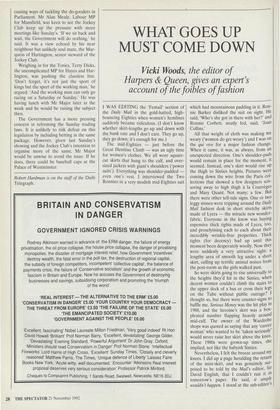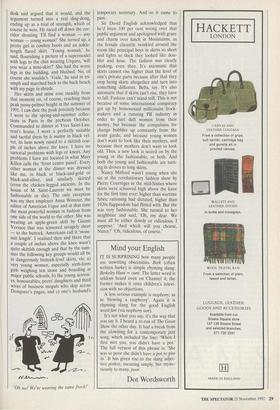WHAT GOES UP MUST COME DOWN
Vicki Woods, the editor of
Harpers & Queen, gives an expert's account of the foibles of fashion
I WAS EDITING the 'Femail' section of the Daily Mail in the gold-hatted, high- bouncing Eighties when women's hemlines suddenly became ridiculous. (I don't know whether skirt-lengths go up and down with the bank rate and I don't care. They go up, they go down; it's enough for me.)
The mid-Eighties — just before the Great Hemline Climb — was an ugly time for women's clothes. We all wore square- cut skirts that hung to the calf, and over- sized jackets with giant's shoulders ('power suits'). Everything was shoulder-padded even one's vest. I interviewed the Two Ronnies in a very modish mid-Eighties suit which had mountainous padding in it. Ron- nie Barker disliked the suit on sight. He said, 'Who's she got in there with her?' and Ronnie Corbett, neatly fed, said, 'Joan Collins.'
All that weight of cloth was making me weary ('women do get weary') and I was on the qui vive for a major fashion change. When it came, it was, as always, from an unexpected direction. One's shoulder-pads would remain in place for the moment, it seemed. Instead, one's skirt would rise up the thigh to Sixties heights. Pictures were coming down the wire from the Paris col- lections that showed a few designers scis- soring away to high thigh a la Courreges and Mary Quant. Not many; a few. But there were other tell-tale signs. One or two leggy misses were tripping around the Daily Mail fashion desk in short stretchy skirts made of Lycra — the miracle new wonder- fabric. Everyone in the know was buying expensive thick tights made of Lycra, too, and proselytising each to each about their incredibly wrinkle-free properties. Thick tights (for decency) had up until this moment been desperately woolly. Now they were suddenly a very attractive sight: a lengthy area of smooth leg under a short skirt, calling up terrific animal noises from the post-room as the girls walked past. So were skirts going to rise universally to the heights they'd hit in the Sixties, when decent women couldn't climb the stairs to the upper deck of a bus or cross their legs on the Tube without public outrage? I thought so, but there were counter-signs to baffle me. Serious Money was the hit play in 1988, and the heroine's skirt was a box- pleated number flapping heavily around mid-calf. The owner of the Wardrobe shops was quoted as saying that any 'career woman' who wanted to be 'taken seriously would never raise her skirt above the knee. These 1980s were grown-up times, she implied, not like the babyish Sixties. Nevertheless, I felt the breeze around my knees. I did up a page heralding the return of the mini-skirt, and was genuinely sur- prised to be told by the Mail's editor, Sir David English, that I couldn't run it in tomorrow's paper. He said, it simplY wouldn't happen. I stood at the sub-editor's desk and argued that it would, and the argument turned into a real ding-dong, ending up as a trial of strength, which of course he won. He raced off down the cor- ridor shouting 'I'll find a woman — any woman — young woman!' She turned up, a pretty girl in cowboy boots and an ankle- length flared skirt. 'Young woman,' he said, flourishing a picture of a supermodel with legs to the chin wearing Ungaro, 'will you wear a mini-skirt?' She had the worst legs in the building, and blushed. No, of course she wouldn't. 'Voila,' he said in tri- umph and marched back to the back bench with my page in shreds. Her skirts and mine rose steadily from that moment on, of course, reaching their peak pussy-pelmet height in the summer of 1991. I can date the peak precisely because I went to the spring-and-summer collec- tions in Paris in the previous October. Commanded to dinner at Yves Saint-Lau- rent's house, I wore a perfectly suitable and tactful dress by le maitre in black vel- vet, its hem newly raised to a skittish cou- ple of inches above the knee. I have no sartorial problems with legs or knees. Any problems I have are located in what Mary Killen calls the 'front centre panel'. Every other woman at the dinner was dressed like me, in black or black-and-gold or black-and-silver, and similarly skirted (even the chicken-legged ancients. In the house of M. Saint-Laurent we must be fashionable or die). The only exception was my then employer Anna Wintour, the editor of American Vogue and at that time the most powerful woman in fashion from one side of the world to the other. She was wearing an apple-green shift by Gianni Versace that was scissored savagely short — to the buttock. Americans call it 'swim- suit length'. I realised then and there that a couple of inches above the knee wasn't quite skittish enough and that by the sum- mer the following key groups would all be in dangerously buttock-level skirts, viz: a) very young women, especially sixth-form girls weighing ten stone and boarding at major public schools; b) the young actress- es, honourables, peers' daughters and third wives of business moguls who skip across Dempster's pages; and c) one's husband's `Oh no! We're wearing the same frock!' temporary secretary. And so it came to pass.
Sir David English acknowledged that he'd been 100 per cent wrong over that public argument and apologised with grace and charm over lunch in Mosimanns, as the female clientele twinkled around the room like principal boys in skirts so short and tights so thick they looked like dou- blet and hose. The fashion was clearly peaking, even then. It's axiomatic that skirts cannot rise higher than the level of one's private parts because after that they stop being skirts altogether and turn into something different. Belts, say. It's also axiomatic that if skirts can't rise, they have to fall. Fashion can't stand still. This is not because of some international conspiracy got up by homosexual millionaire frock- makers and a cunning PR industry in order to part daft women from their money, but because the compulsion for change bubbles up constantly from the avant garde, and because young women don't want to look like their mothers, and because their mothers don't want to look old. Thus, a new look is seized on by the young or the fashionable, or both. And both the young and fashionable are turn- ing in droves to long skirts.
Nancy Mitford wasn't young when she sat at the revolutionary fashion show by Pierre Courreges in the mid-Sixties where skirts were scissored high above the knee for the first time ever: higher than wartime fabric rationing had dictated, higher than 1920s flapperdom had flirted with. But she was very fashionable. She turned to her neighbour and said, 'Oh, my dear. We must all be either dowdy or ridiculous, I suppose.' And which will you choose, Nancy?"0h, ridiculous, of course.'
Mind your English
IT IS SURPRISING how many people use unwitting obscenities. Berk (often written burke) is simple rhyming slang: Berkeley Hunt = cunt. The latter word is seldom heard even on Channel 4; the former makes it onto children's televi- sion with no objections.
A less serious example is raspberry, as in 'blowing a raspberry'. Again it is rhyming slang for the good English word fart (via raspberry tart).
It's not what you say, it's the way that you say it. I heard a re-run of The Goon Show the other day. It had a break from the clowning for a contemporary jazz song, which included the line: 'When I first met you, you didn't have a pot.' The full version of this phrase is, 'She was so poor she didn't have a pot to piss in.' It has given rise to the slang adjec- tive potless, meaning simply, but myste- riously to many, poor.
Dot Wordsworth











































































 Previous page
Previous page